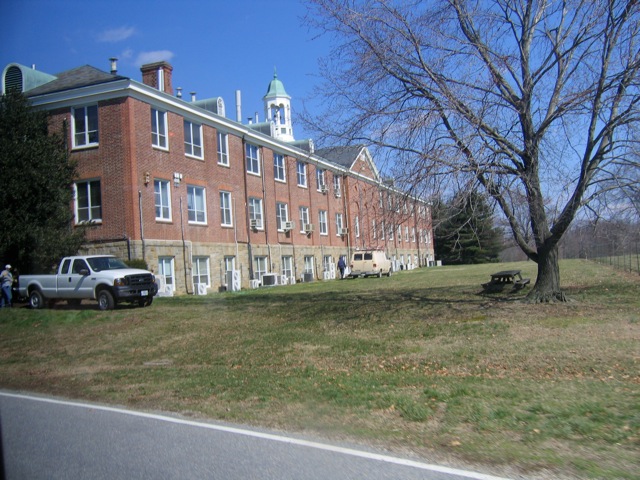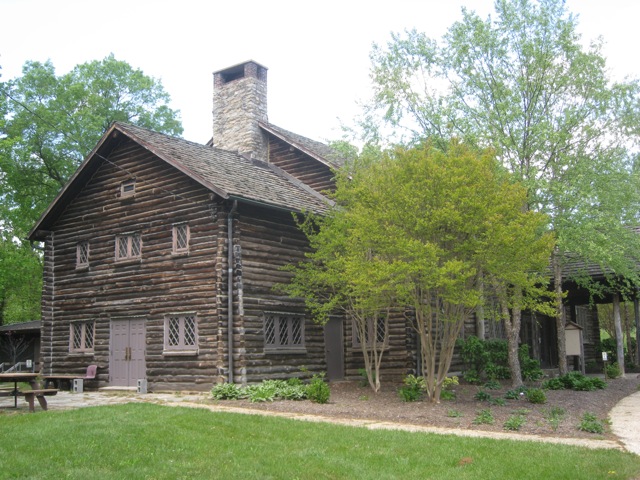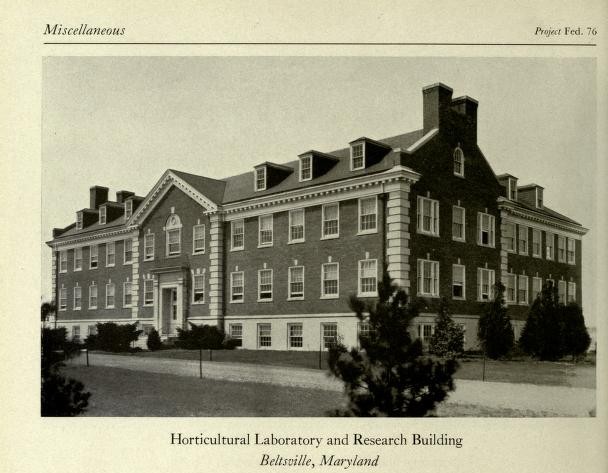- City:
- Beltsville, MD
- Site Type:
- Federal Facilities, Forestry and Agriculture, Research Facilities
- New Deal Agencies:
- Bureau of Plant Industry, Conservation and Public Lands, Public Works Funding, Work Relief Programs, Public Works Administration (PWA), Civilian Conservation Corps (CCC), Works Progress Administration (WPA), Federal Emergency Relief Administration (FERA)
- Started:
- 1933
- Completed:
- 1940
- Quality of Information:
- Very Good
- Marked:
- Unknown
- Site Survival:
- Extant
Description
The Henry A. Wallace Beltsville Agricultural Research Center, or BARC, is a unit of the United States Department of Agriculture’s Agricultural Research Service. BARC is the largest agricultural research complex in the world. It was founded in 1910 and greatly expanded under the New Deal. Several New Deal agencies were involved in this massive project, presumably working under the direction of the USDA’s Bureau of Plant Industry (which later became part of the Agricultural Research Service).
To begin with, the Public Works Administration (PWA) purchased the land and paid for clearing, drainage, water lines, roads, walkways and an irrigation system. The labor was provided by relief workers from the Federal Emergency Relief Administration (FERA). New Deal work at BARC began in 1933 and extended through the late 1930s.
A FERA report from December 1933 describes its work at the site: “Work On Experimental Stations. Number of Men, 2,238. Estimated cost, $415,000. Department of Agriculture, Bureau of Animal Industry: Under this project a wide variety of general improvement work will be done including some minor construction which will increase the usefulness of the stations. Eight hundred and seven men will work on the principal station at Beltsville, Md.” (FERA 1933)
The PWA then funded the construction of several buildings at the Research Station, including the Animal Husbandry Laboratory (Bldg. 200), Bee Research Laboratory, (Bldg. 476), Germplasm Resources Laboratory (Bldg. 004), Range 1 greenhouses, headhouses and Foreman’s Cottage (Bldg. 018).
The 1939 survey of PWA projects describes some of the buildings in detail:
The Animal Husbandry and Research Library: “This main laboratory building and a small animal laboratory, constructed by the Bureau of Animal Industry of the Department of Agriculture, provide laboratory facilities for genetic, chemical, nutritional, physiological, histological, physical, and other forms of biological research that are involved in the studies of breeding and feeding of livestock. The project included, in addition to the 2 laboratory buildings, a boiler house, a water system, a power line, roads, bridgs, and some minor buildings. The main laboratory is 3 stories in height and provides 108 rooms which are used for offices, general laboratory work, and research. All of the laboratory work of this division of the Bureau, except the work in poultry investigation, is carried on here. A technical library serves this and other units at the Agricultural Research Center. The construction is fireproof with exterior walls of random ashlar stone to the main floor level and brick above this. Cornice and cupola are wood and the roof is slate. The project was completed in September 1937 at a construction cost of $759,489 and a project cost of $952,781.”
Research Center Laboratory and Office Building: “This building was erected by the Bureau of Entomology and Plant Quarantine of the Department of Agriculture to further their research and investigation into the means of controlling and eradicating insect pests and diseases of plants. The building assembles units under 1 roof which were widely scattered. It contains 22 laboratory units, a library, an office, a honey laboratory with floor and walls of white tile, 4 constant temperature rooms, a cold-storage plant with refrigerating machinery, and 3 other storage rooms. The construction is fireproof. Frame and floors are reinforced concrete, exterior walls are brick, the cornice is wood, and the roof is covered with slate. The project was completed in November 1935. The original P.W.A. allotment of $134,999 was increased to $136,917.83.”
Horticultural Laboratory and Research Building: “Among the activities of the Bureau of Plant Industry of the Department of Agriculture are plant research and experimentation and their related problems of the study of soils and their improvement, as well a enforcement of the Federal Seed Act and the control of the quality of plant and soil inoculants. This laboratory and research building provides laboratories and offices in which the work may be carried on and is a necessary adjunct to the nursery greenhouses, storage buildings, propagating sheds, and other facilities which had already been provided. The building is fireproof with exterior brick walls trimmed with stone and wood. It was completed in March 1936 at a construction cost of $128,732 and a project cost of $137,782.” (Short & Stanley-Brown 1939)
The Works Progress Administration (WPA) did extensive work at Beltsville in 1938-40. Most of the WPA projects were developing the experimental fields and forests, but they also included several barns, greenhouses, storage buildings and an administration building and staff residences. These are described in detail in the cryptic style of WPA project cards in the National Archives, as follows:
“Improvements to National Agriculture Research Center, Beltsville, Maryland, including clearing land, conducting drainage work, constructing erosion control devices, ditching, clearing for stream channels and secondary roads, installing culverts, laying water mains for irrigation, building forms, seed bins, storage rooms, and tool racks, constructing service roads, rehabilitating buildings, constructing tanks, footing, cables, and racks, relaying floors, roofing, installing sewer and irrigation systems, connecting pump, preparing land for planting, setting plants, weeding, examining results, harvesting and preparing yields for study.
Constructing terraces and check dams; gully control; reforestation; construct and equip central heating, refrigeration, and service building with necessary tunnels to serve research laboratories; provide coal handling facilities; make essential changes in electric and telephone distribution facilities; enlarge shop facilities and erect essential fences to project experimental areas; construct dairy barns, cattle barn, sheep barn, hog barn, animal hospital building, experimental building for large farm animals, hay barn, open shed for cows, silo shed; repair existing buildings and equipment; remodel buildings; water and power lines; clearing, grading, and fencing; constructing road approaches and driveways; constructing residential facilities, including six detached houses, one apartment house and one lodge, laboratory, wash rooms and lavatories, garages, utility buildings, workshop, storage buildings, greenhouses, lath (lathe?) house, and barns; install water supply, sewage disposal facilities and exterior service facilities; construct water reservoir and wells; furnish and install water treatment units and water lines; enlarge granary and feed mill facilities; remodel, repair, and paint farm houses and buildings; grade, ditch and level land; construct water areas for research with water plants; widen and surface roads; plant and seed grounds around buildings.
Construct Administration Building with laboratory and outbuildings; construct laboratories for pharmacology and vitamin work, for cold storage research, for fertilizer investigations; Construct superintendent’s residence, assistant superintendent’s residence, caretaker’s cottage, apartment house, barn, garages, greenhouses; construct cottage for nurseryman; clearing land; conducting drainage work; constructing erosion control devices; ditching; clearing for stream channels and secondary roads; installing culverts; laying water mains for irrigation; building forms, seed bine; constructing service roads; rehabilitating buildings; constructing tanks, footings; re-laying floors; roofing; installing sewer and irrigation systems; connecting pumps; preparing land for planting; harvesting; preparing yields for study; constructing airport including clearing, grubbing, grading, draining, constructing runways, weeding, installing field lighting facilities, constructing hangar and aprons.”
The WPA project cards also reference work on a Research Center Experimental Forest in Prince George’s County, which is most likely now part of the Beltsville Agricultural Research Center: “Make improvements and conduct general forest conservation work in Research Center Experimental Forest, Prince George’s County, including developing, planting, and improving timber stands; reducing fire hazards; constructing fire breaks, fire lanes, roads, towers, observatories, forest headquarters, other related minor structures and fences; installing power transmission lines; landscaping.”
The Civilian Conservation Corps (CCC) built the Log Lodge at the Research Station, now the Visitors’ Center.
In 2000, the name of Henry A. Wallace, Secretary of Agriculture and Vice-President under the New Deal, was added to the BARC.
Source notes
Maryland State Archives Historical Trust Eligibility Review Form, Smallwood House
Maryland State Archives Historical Trust Eligibility Review Form, Hense House
Monthly Report of the Federal Emergency Relief Administration: December 1 to December 31, 1933
C.W. Short and R. Stanley-Brown. Public Buildings: A Survey of Architecture of Projects Constructed by Federal and Other Governmental Bodies Between the Years 1933 and 1939 with the Assistance of the Public Works Administration (1939).
National Archives, Record Group 69, “Microfilmed Index to WPA Projects.”
National Archives, Record Group 69, Records of the Work Projects Administration, “Newspaper clippings file, 1935-1942.”
“Capital’s Biggest Building Program Promises A Boon By Spring: Expenditures May Reach $200,000,000,” Washington Post, November 27, 1938.
Site Details
| Site #s |
|---|
| Fed. 72, Fed. 26.6, Fed. 76 |
Contribute to this Site
We welcome contributions of additional information on any New Deal site.
Submit More Information or Photographs for this New Deal Site






Join the Conversation